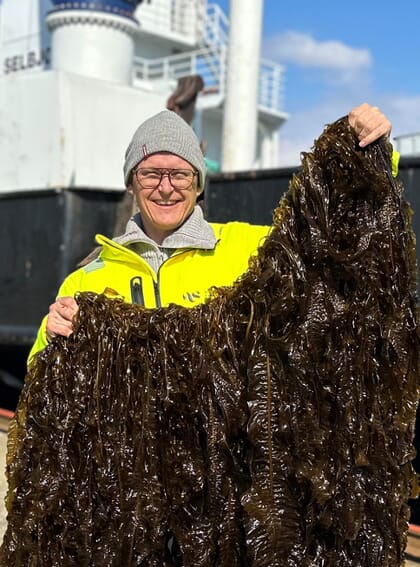
© Arctic Seaweed
So believe Kim Kristensen and Joost Wouters, respective CEOs of Arctic Seaweed and The Seaweed Company, who speak from experience having devoted 15 years between them to building the companies that they hope can help create a viable sector.
While both initially felt forced to vertically integrate, due to the paucity of other players in the sector, they’re now united in the belief that collaboration is the best way to keep momentum going – and have just signed a memorandum of understanding to underline this point, allowing each to play to their strengths.
“After six years we decided to concentrate on processing and go-to-market. We were technologically surpassed on the farming side by others, like Arctic Seaweed,” reflects Wouters.
“We’re complementing each others strengths and we can see the ecosystem forming. The Seaweed Company will take the seaweed and we can focus on further building this tech,” Kristensen agrees.
“We have the same DNA, the same entrepreneurship and the same motivation. So, we decided to build partnerships and work together with Arctic Seaweed to build the value chain together. Kim and his team will support us by further advancing the production of seaweed and we’ll take care of the rest,” Wouters adds.
A trial run involved shipping seaweed grown by Arctic in Norway to The Seaweed Company’s new processing plant in Ireland, which the latter then processed and sold.
“It’s probably the only way to do it, because doing everything yourself means burning so much cash on validating so many uncertain things,” Wouters reflects.
The origin stories
Wouters and Kristensen bring different perspectives to seaweed, coming from very different career backgrounds.
Wouters spend most of his career working for large corporations, including Pepsi Cola. After setting up his own company to try and improve the sustainability of these corporates, he decided to establish The Seaweed Company in 2018 in a bid “to make the food value chain healthier and more sustainable”. Meanwhile Kirstensen first encountered the idea of monetising seaweed in 2015 when considering investing in a startup that was making artificial reefs.
“Seaweed was becoming an interesting topic, not just for specialist people, but also for salmon farms and there was some traction there. We also got challenged by the existing seaweed farming technology – we ended up utilising the know-how from the reefs, because seaweed was growing really densely on these vertical structures. I made some patent applications and that’s when Arctic Seaweed was born,” he reflects.
“It was about the drive to build something from nothing, It had always been there, I just lacked the idea. When the idea came we managed to get nearly €3 million in funding – a combination of Public-funding and angel investors – so we could build a large scale farm from the outset,” he adds.
“We did. It failed. The co-founder left in 2018 and we were stuck with this very large farm in the water, with no one else but me on the payroll, but we managed to get it turned around into what it is today,” he continues.
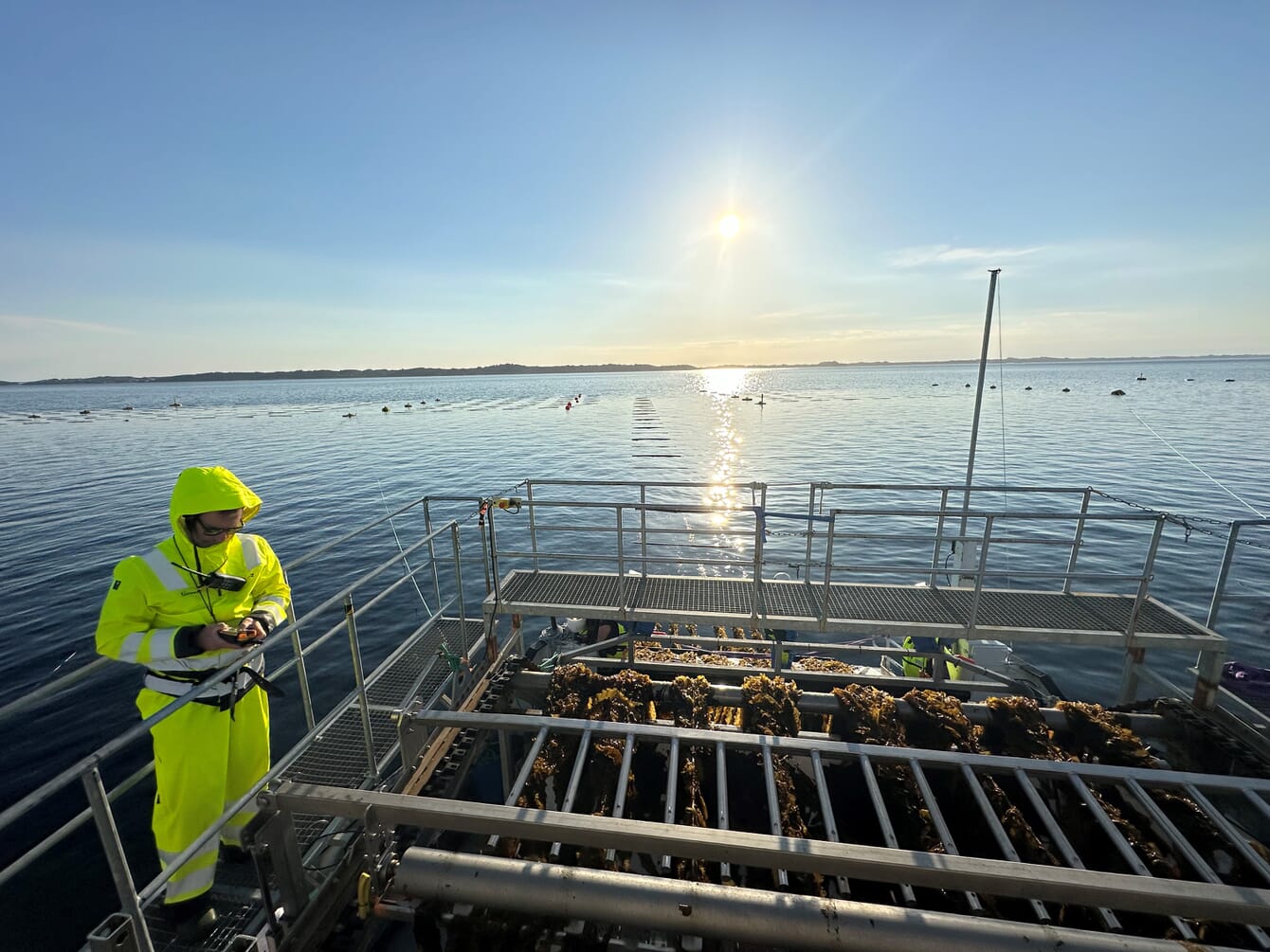
© Arctic Seaweed
The emergence of Arctic Seaweed
While Arctic Seaweed continue to operate three of their own farms – with a combined capacity to produce 100-200 tonnes of seaweed a year – these are now largely for R&D purposes, as test sites for the technologies they have been developing – technologies which they are now selling to other growers – with customers including Royal Greenland, in Greenland, as well as independent producers in Norway, Ireland and the UK.
“We need to trial what happens in different types of locations and get the data out because it’s all driven by experimentation and R&D and we always set ambitious goals for what we want to achieve the next season,” explains Kristensen.
“We focus on developing scalable technology. What we have developed is a platform where everything is based on direct seeding. Without that we couldn’t scale and scalability is the core principle of what we do,” he adds.
The result is a turnkey integrated farming system which has proved to be replicable in multiple geographies for multiple species.
“It’s a robust system that can take a beating, but can also be deployed in calm waters and shallow locations, deep water locations. It’s all standardised so you can utilise the same principles and processes,” Kristensen emphasises.
It has not, however, been plain sailing.
“We struggled at the beginning. We had a pilot that worked magnificently in 2016-17 and we thought we could scale that into infinity, but we couldn’t and we didn’t really know why. We were all engineers and didn’t have any marine biologists. It took us three or four seasons before we figured out what the problem was – it was biological and when we got the first marine biologist on the team everything changed. We finally figured out what we need to do and have been building on that ever since: proving the concept and meeting our target KPIs with direct seeding in terms of predictability and yields,” he reflects.
However, he now feels that the farming system that they’ve pioneered has been thoroughly validated.
“The size and quality of the plants that we get now with direct seeding is excellent and we can now deploy 24,000 m of lines in two hours. With twine you’d never achieve that,” Kirstensen notes.
This is based on a scalable, modular system that allows up to 24,000 m of lines to be installed per hectare. They have also ramped up their harvesting capacity, reaching as much as 29 tonnes in a single day. Currently the bottleneck is in processing and packaging the seaweed directly after harvesting.
“Everything is done by direct seeding which means that there aren’t really any limitations when it comes to capacity or throughput. We’ve built machines for direct seeding, so we seed multiple lines in parallel. We’ve built machines for assembling our structures before they’re deployed. We’ve also built machines for harvesting. And we’ve developed various protocols and recipes for how to stabilise that seaweed,” he explains.
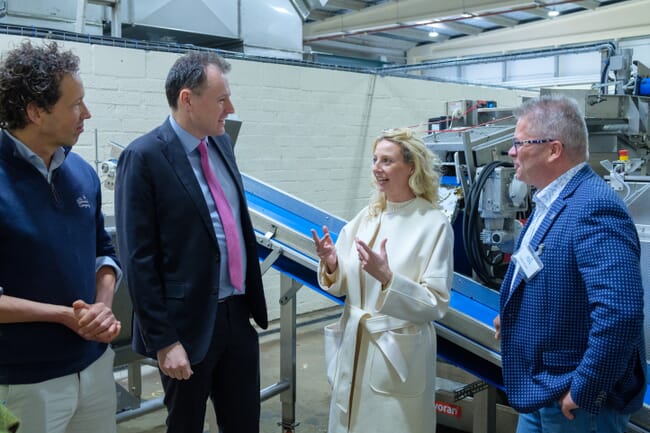
Joost Wouters (CEO) is on the left © The Seaweed Company
The Seaweed Company’s story
As a fellow pioneer The Seaweed Company was also initially forced to try vertical integration, due to the lack of players across the value chain, including farming their own seaweed in Ireland and The Netherlands.
“When we started in 2018 we had to do everything – from seed production, to go-to-market – because there was not much of a seaweed industry outside of Asia, so there was nothing to outsource,” reflects Wouters.
“But as soon as we could, we’ve always wanted to work with partners, so that everyone can play the best role,” he adds.
As a result, as soon as better options were available the company seized them, with their first move to hand over seed production to fellow Dutch specialists Hortimare.
However, at the same time, they continued to work on filling gaps in the value chain themselves and recently decided to invest in their own processing unit, again with technology partners, – with a focus on drying seaweed – due to the lack of alternatives in Europe, which they recently opened in Ireland.
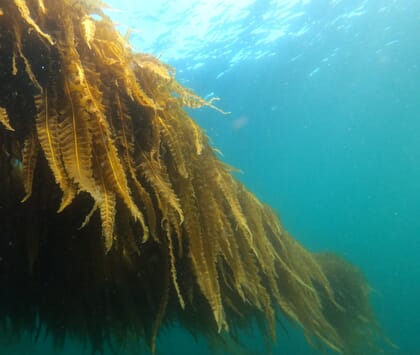
© Arctic Seaweed
A clear go-to-market strategy
Despite the huge range of possible applications for seaweed, Wouters is convinced that focusing on the food sector will be the way forward for the foreseeable future and currently the company is concentrating on replacing a percentage of beef mince with seaweed – creating a hybrid product, called SeaMeat.
“It’s a very strong and relevant proposition, as companies that need to reduce their scope 3 emissions can very easily replace a certain percentage of their meat without changing their recipes, without price differences. That is how you get impact at scale. And so that will be the main focus,” Wouters observes.
“If you can grow more seaweed at lower prices then other applications might be possible, but you need such a low price point to make, for example, plastics from seaweed – and it’s a waste of beautiful, nutritious seaweed,” he adds.
And he is convinced that the food sector is more than big enough to absorb the sort of volumes of seaweed that are projected to be grown in Europe in the coming years.
“You would need huge volumes to have an impact on food. Right now there’s no volume in Europe at all – maybe 500, 600, 700 tonnes. We need to talk about thousands and thousands and thousands of tonnes. Then we can really have an impact,” he argues.
“We can replace part of all animal-based products – from beef, to pork, to poultry, to tuna – with seaweed. Because texture-wise and taste-wise it’s such a good match. If you replace 25 percent of beef with seaweed, you’re saving 8 kg of CO2, 1,800 litres of water and about 25 m2 of land per kilogram. You won’t get that if you put seaweed flakes in bread or cheese – those would be gimmicks,” he adds.
According to Wouters, the response has been very positive – at least from those who have actually tried the seaweed-meat hybrid products.
“Product development is extremely important. It needs to be same price, same ease of use and same taste. That took us several years to develop but we’re practically there now,” he says.
Interestingly, Wouters is convinced that retailers, not consumers, are the key to adoption of these hybrid products – even though the products might offer consumers price- and health-based advantages.
“This will not be a consumer-driven change, this will be a B-to-B approach where the companies and the retailers will have to take the lead, which is new for most marketeers. Consumers are not always choosing for sustainability, even if they say so,” he notes.
“For the companies that buy it, it’s the environmental impact that’s important. For the consumers it’s the health benefits – you’re introducing fibres into meat, you can almost half the salt content and add anti-oxidants. It’s not just a filler, it’s adding actual value” he adds.
The Seaweed Company’s first big customer was Colruyt, a leading Belgian retailer, followed by two retailers and food service companies in the Netherlands and they are currently in conversation with “a huge German discounter”.
Another breakthrough development is that one of their food service customers has now pledged to include 10 percent seaweed in all their minced meat products as standard.
“They are all struggling with their legal obligations to reduce their scope 3 emissions so this is an extremely interesting solution for them,” Wouters points out.
“We need a lot of seaweed, we need a stable product at a cost-competitive price. It cannot be more expensive than the current ingredients. The moment we are cheaper than meat all the impact metrics and health benefits are almost like an add-on as that’s how the market works,” he adds.
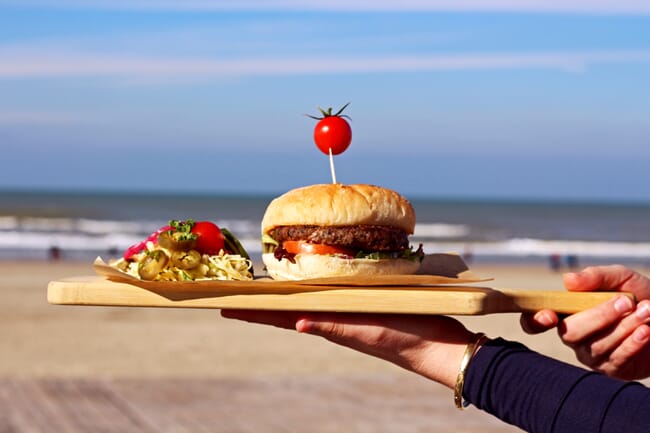
© The Seaweed Company
Outstanding challenges
Although each company is trying to specialise, there are areas where their work directly overlaps. And one of the key challenges that both are looking to solve is how to ensure that high quality seaweed is available for as much of the year as possible, as harvesting is currently very seasonal and preservation processes in need of fine-tuning.
“The species of seaweeds currently being farmed tend to be harvested around the same times. So we can only use our dryer for one or two months of the year – which is not ideal. Kim is now working to preserve seaweed so that we can spread that processing time. The first steps have been taken and they look extremely promising,” Wouters notes.
Indeed, preservation has been an ongoing theme for Kristensen.
“We’ve been working on this almost since the beginning. We started out wanting to freeze the seaweed but quickly learned it wasn’t the way to do it – it’s very labour intensive, very energy demanding and doesn’t really scale,” he recalls.
“We acquired some recipes and techniques in 2018, by acquiring significant shares in a Danish company that had developed fermentation protocols for fresh seaweed. We solved it and managed to make it scale, but also learned that fermentation requires relatively advanced and expensive equipment and adds quite a bit of cost to the product. We decided fermentation was too complex, so began to look for lower cost, more simple alternatives,” he continues.
“So we’ve been working with traditional ensilage, where you add an organic acid and make sure you stabilise your seaweed at a certain pH – not too low, as it’s too acidic, and not too high, as you can get growth of unwanted bacteria. We want to retain the flavour profile as best we can without compromising the flavour profile and shelf life. We’ve dialled in some protocols there,” he adds.
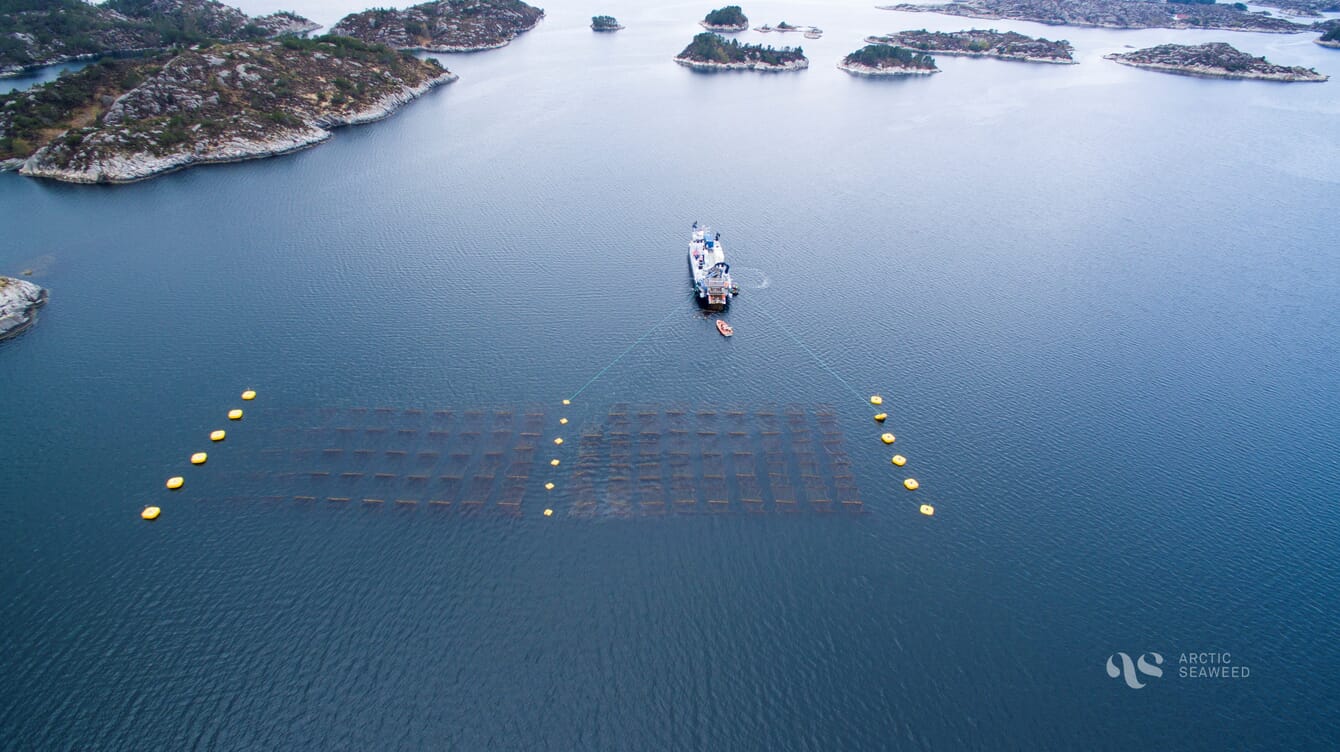
© Arctic Seaweed
And they are now refining a fourth option.
“This year we’ve started working with brine and salt – a low cost, scalable option. Salt is a cheap additive that you can source in massive quantities in a short period of time. That was mainly targeted towards the biorefineries, where you break down the sugars with acid, reducing the value of raw material,” Kristensen explains.
Having a variety of preservation methods means that Arctic Seaweed can deliver raw materials that best suit the end user, and they have also ensured that these can be done on the same process line.
“We can dial in whatever we want to do that day, or that hour, so the product can go to a specific market,” says Kristensen.
“We can extend the availability of seaweed to six months, without a cold chain. With a cold chain we could increase this to 9-12 months,” he adds.
Arctic Seaweed are also looking into developing multi-season farming methods.
“It requires some development, but there are ways to get more than one season out of a farm, even here in Western Europe – mimicking a little bit of what they do in the Faroe Islands, where they have very favourable conditions and can harvest for four months of the year. We are seeing the same potential in Greenland and we think we can mimic that in the Norwegian coast where we have very deep water and a thermocline at 30-40 m we can utilise,” Kristensen explains.
How to start a seaweed farm
Kristensen is unwilling to divulge the likely cost of setting up a farm that uses Arctic Seaweed’s technologies, but he does make it clear that it’s only likely to be financially viable if it’s at a considerable scale.
“We want to enable farmers and we have global ambitions to help seaweed farmers and other companies like offshore wind developers achieve their own ambitions. We think a self-sustaining farm, to get proper unit economics out of it, would need to hold about 300 km of line and produce upwards of 2,000 tonnes per harvesting season. That would give the possibility to reach production costs of €0.50- 0.60 per kilo. If you triple that to 900 km it will further improve your unit economics but the improvement is not linear,” he explains.
“Investment-wise, it depends on the model you choose, but it should be bankable as long as we can figure out how to have a stable market and stable offtake agreements, which we don’t think will be an issue,” he adds.
Both men agree that it’s all about reaching critical mass.
“What is very important in the next couple of years is to prove that there is a financially sustainable value chain,” says Wouters.
In order to achieve this, standardisation is key, like in the salmon sector, he argues.
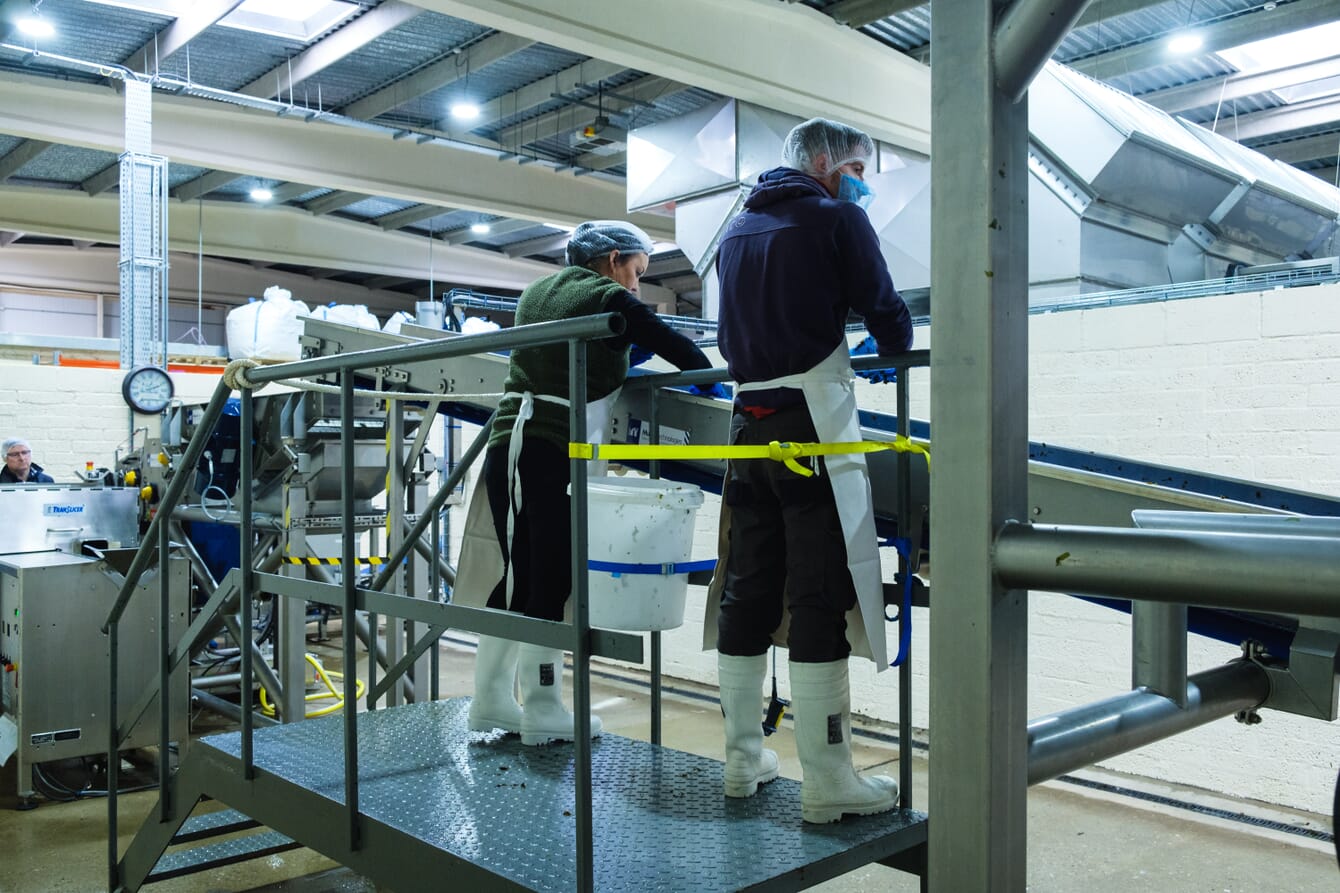
The company now focuses on processing and marketing seaweed © The Seaweed Company
Future prospects
Despite many years in the sector, it is clear that both men remain extremely committed and would also be delighted to see others get involved.
“There’s so much knowledge needed – it’s not just a question of growing seaweed and selling it. That’s the mistake that people have made in the last 10 or 20 years. It’s complicated but we’re getting there and that’s nice, as seaweed has a role to play as one of the most sustainable crops, with nearshore opportunities in Norway, Greenland, the UK, Ireland. We have not even dipped our toe in the water, there are so many jobs to be created if we do this smartly,” reflects Wouters.
“The world needs impact solutions and seaweed can play an extremely important role. The coastlines are extremely underutilised. Fishing is dying. And there’s so much room – there’s no competition so please join,” he adds.
“We want to have impact by enabling an industry to grow with what we’ve developed. It makes so much sense with what The Seaweed Company are doing. Their SeaMeat is a fantastic product – I’ve tried it and loved it and I can see how it works. It’s now about getting the volumes to support this growth. We need to prove we have the necessary biomass available to pull it off,” Kristensen agrees.
Both believe that critical mass will be reached within a short period of time. But they also are aware of the massive uptick in scale that will be required to achieve this.
“With four or five big offtake agreements we can grow to provide the volumes required. To cover all the meat in for example, an Aldi, we’d need ten times the farms that Kim has now. And even if they would like to have seaweed tomorrow it would not be there. There’s always lag time of 1, 2 3 years of learning the location and how to work with it,” Wouters reflects.
“The tipping point will come the moment we have validated this whole value chain, then the scale up will be a no-brainer – we’ll know how to grow and harvest the seaweed, where to buy it from and where to put it. I think that will be reached in the coming five years,” he adds.
“We are ready to start but we need that breakthrough on the market side. Some kind of commitment that will support the investments required to build capacity. We think that we now have the technology on the shelf to grow at least 25,000 tonnes of seaweed in a relatively short space of time. Both companies have consistently raised the bar but we need to get over the final hurdle and turn this into an industry,” Kristensen concludes.




